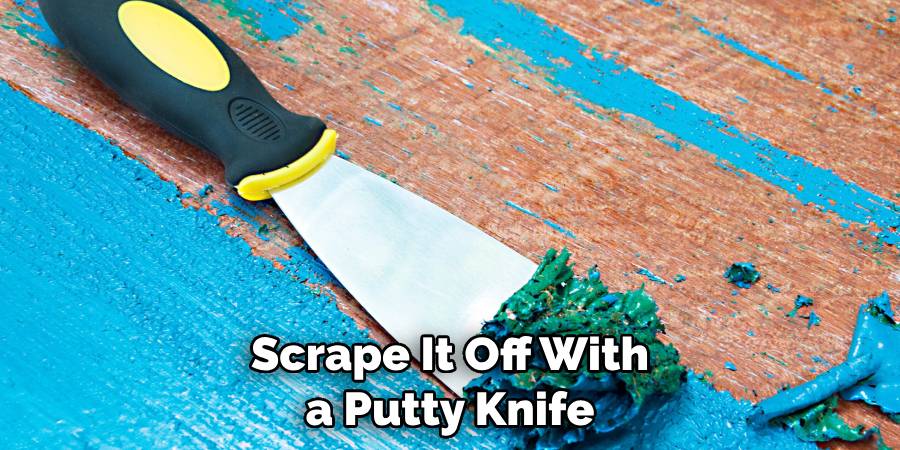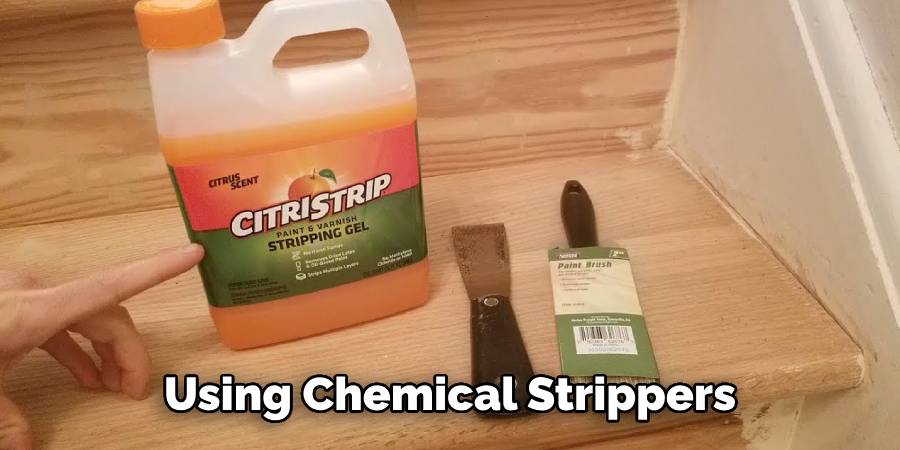Painting wood cabinets is a popular way to update the look of your kitchen or bathroom. However, over time, you may want to change the color or simply remove the paint altogether. Removing paint from wood cabinets can be a daunting task, but with the right techniques and tools, it can be done effectively.
In this guide, we will discuss various methods for removing paint from wood cabinets, including chemical strippers, heat guns, and sanding. We will also provide tips on how to remove paint from wood cabinets.

Why Remove Paint From Wood Cabinets?
There are several reasons why you may want to remove paint from your wood cabinets. These include:
- Wanting to restore the natural beauty of the wood
- Preparing for a new coat of paint or stain
- Removing old, chipped or peeling paint
- Updating the look of your cabinets
Whatever your reason may be, it is important to follow the correct methods for removing paint from wood cabinets to avoid damaging your cabinets.
Materials Needed
Before you begin removing paint from wood cabinets, make sure you have the following materials:
- Chemical stripper
- Heat gun
- Sandpaper (coarse and fine grit)
- Paint scraper
- Drop cloth or newspaper
- Protective gear (gloves, safety glasses, and mask)
- Clean cloth or rag
10 Effective Ways on How to Remove Paint from Wood Cabinets
If the existing paint on your wood cabinets has seen better days, peeling or faded, you might be considering a refresh. However, before you can add a new coat of color, you’ll need to tackle the old paint. This listicle offers ten detailed methods for removing paint from wood cabinets. From the traditional to the innovative, there’s a method to suit every skill level and budget.
Here are 10 effective ways to strip those wood cabinets back to their original beauty:
1. Sanding
One of the most effective, albeit labor-intensive, methods is sanding. Use an electric sander with a progression of sandpaper grits, starting with coarse and working up to fine. It’s important to sand with the grain of the wood to avoid creating scratches that might show through your new coat of paint.
Be prepared for a significant amount of dust. To minimize the mess, work in a well-ventilated area and wear a mask. After sanding, clean the cabinets thoroughly to remove all the dust before painting.

2. Heat Guns
Heat guns are a powerful tool for paint removal. They work by softening the paint so that it can be scraped away. This process is much quicker than sanding but requires caution, as the heat can damage the wood if concentrated in one area for too long.
Begin by holding the heat gun several inches away from the cabinet and move it constantly to keep the heat consistent. Once the paint begins to bubble, use a putty knife to scrape it off. Work on small sections at a time for the best results.
3. Chemical Strippers
Chemical strippers are a popular choice for removing paint from wood cabinets as they are highly effective and require minimal effort. Apply the stripper generously and wait for the paint to bubble and lift. Then, use a putty knife to scrape it away.
Follow the manufacturer’s instructions carefully, since the chemicals can be harmful if used incorrectly. Always wear gloves and a mask and work in a well-ventilated area.
4. Paint Scrapers
If you prefer a manual method but want to avoid the potential damage of heat guns, a simple paint scraper can be effective. Begin by selecting a scraper with a comfortable grip and a sharp edge.
With the aid of a chemical paint stripper to soften the paint, you can use the scraper to gently remove layers until you reach the original wood. This method is slow but can offer a good degree of control for getting into tight corners and detail work.

5. Citrus-Based Solvents
For an eco-friendly approach, consider using a citrus-based paint solvent. These solvents are derived from citrus peels and are not as harsh as traditional chemical strippers.
They work similarly; apply the solvent to the paint, wait for it to soften, and use a putty knife to scrape it away. This method might take a little longer, but the pleasant scent and safer working conditions can be worth the effort.
6. Pressure Washing
While typically used for outdoor projects, a pressure washer can effectively remove peeling paint from cabinets. This method works best if the cabinets are detachable and you can work outside.
Use a low-pressure setting to avoid damaging the wood, and maintain a safe distance to prevent gouging. Pressure washing can remove the bulk of the paint quickly, but it may not be the most precise method.
7. Soy-Based Gel Paint Removers
Soy-based gel paint removers are another environmentally friendly option. These gels contain soy esters which break down the paint’s bond with the wood, making it easy to scrape off.
Apply the gel to the cabinet and leave it for the recommended time. After the paint has softened, you can scrape it off with a putty knife. This method is non-toxic and has a minimal odor but might require more than one application for older or multiple layers of paint.

8. Electric Paint Scrapers
For those who want to speed up the scraping process without using a chemical or physical force, electric paint scrapers are a useful tool. They can be an excellent time-saver, especially for larger projects with extensive paint layers.
Electric paint scrapers minimize the effort required and can be more precise than manual scraping, making them a great choice for achieving a smooth surface to paint over.
9. Paint Stripping Discs for Power Drills
Paint stripping discs are abrasive wheels that can be attached to a power drill. When used on wood with peeling paint, they can quickly sand away the top layers without the labor intensity of hand sanding.
This method is cost-effective and efficient. Be mindful of the dust created and protectively cover any sensitive equipment or surfaces nearby.
10. Professional Refinishing
If you’re unsure about taking on the task yourself or if the cabinets have intricate detail or a complex construction, seeking professional help might be the best option.
Professional refinishers have the experience and tools to remove the paint from wood cabinets with precision and can suggest the best method depending on the type of paint and wood of your cabinets.
Whether you prefer the traditional approach or are looking for eco-friendly and innovative methods, there’s a method to suit every cabinetry project. Safety should always be a priority, so wear protective gear and work in a well-ventilated area. After you’ve successfully removed the old paint, give the wood a day to breathe and then proceed with cleaning, priming, and painting for a fresh, updated look that’ll last for years.
Frequently Asked Questions
What is the Fastest Way to Remove Paint From Wood?
When tackling the task of removing paint from wood cabinets, speed and efficiency are paramount. The fastest way to achieve this is by using a combination of heat and chemical paint strippers. Begin by applying a heat gun to soften the paint, keeping it a few inches away from the wood to avoid scorching. Once the paint bubbles, gently scrape it off with a putty knife.
For residual paint, apply a chemical paint stripper that is safe for wood—preferably one with a gel consistency that clings to vertical surfaces, allowing it to work deeply. Always wear protective gear and ensure proper ventilation when using chemical strippers. Finishing with sanding will reveal the bare wood, ready for a fresh start. This method effectively combines tools to accelerate the paint removal process, providing a clear answer to how to remove paint from wood cabinets efficiently.

Can I Use a Sander to Remove Paint From Wood Cabinets?
A sander can be useful for removing paint from wood cabinets; however, it should not be the first tool you reach for. Sanding can create dust and is time-consuming, so it’s best used in combination with other methods to remove large amounts of paint or stubborn layers.
Additionally, sanding is not recommended for delicate or intricate cabinetry details, as it can damage the wood and create uneven surfaces. It’s essential to proceed with caution when using a sander and always wear protective gear.
How Do I Prepare My Cabinets for Painting?
Once you have successfully removed the old paint, it’s vital to prepare your cabinets for painting. Start by sanding the wood with a fine-grit sandpaper to smooth out any imperfections created during the paint removal process.
Next, clean the cabinets thoroughly with a mild detergent and warm water before wiping them down with a damp cloth and letting them dry. Finally, apply a primer to ensure the paint adheres evenly and smoothly. Once dry, your cabinets are ready for a fresh coat of paint.
Conclusion
In this guide, we’ve discussed various methods for how to remove paint from wood cabinets. From traditional chemical strippers to eco-friendly options and innovative tools, there’s a method to suit every project and preference. However, it’s crucial to prioritize safety when working with any method and always wear proper protective gear.
Remember to prepare your cabinets properly before painting and consider seeking professional help if you’re unsure or have complex cabinetry. With the right tools and techniques, you can achieve a beautifully refinished look that will last for years to come. So go forth and give those wood cabinets a fresh start! Happy painting!
